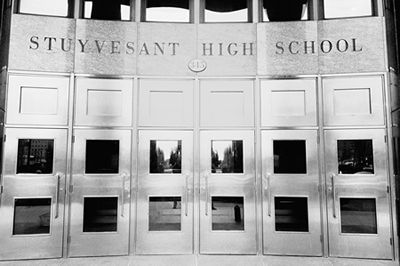 |
| Stuyvesant High, one of New York City’s elite exam schools, enjoys an ultramodern building, influential alumni, and the city’s brightest students. If only it could also escape the corrosive rules of the teachers’ contract. Photographs by Patrick Harbron.
|
On a bitterly cold Saturday morning in December 1995, I wished my son Jonathan good luck and then watched him join a long line of students at the entrance to Stuyvesant High School in lower Manhattan. They were all waiting to take the admissions test for New York’s three vaunted “exam schools.”
The admissions process for the three schools is one of the last bastions of pure meritocracy in American education. Each year about 20,000 of the city’s 90,000 8th graders report for the three-hour test of math and verbal aptitude. The grand prize, a seat at the world famous Stuyvesant, is offered to those with the top 800 scores. The next 600 are admitted to the Bronx High School of Science. Another 1,000 students get into Brooklyn Technical High School. There are no “legacy” or affirmative-action admissions. Political connections can’t get your child in. Special consideration is given only to a small group of students who qualify as “economically disadvantaged” and come within a few points of the cut-off score. These students are given a summer-school course and allowed to take the test again. If they pass on the second try, they’re in.
The three exam schools have been in existence for more than 70 years. During the first half of the 20th century, when the New York City public schools composed one of the most successful systems in the nation, they were considered the jewels in the crown. More recently they have been widely regarded as among the last exemplars remaining in a failing system.
The high-school options now available in the city are so limited that thousands of middle-class and working-class parents find themselves left out in the cold when their children fail to make the cutoff for the exam schools. Some then move to the suburbs, while others endure heavy financial sacrifices to send their children to private or parochial schools. Attending a regular New York City public high school is usually the option of last resort.
Of course the situation could always be worse. Indeed, it would be much worse if John Lindsay, New York’s iconic liberal mayor during the late 1960s and early 1970s, had gotten his way. Lindsay complained that the entrance exam for the three specialized high schools was “culturally biased” against black and Hispanic children and sought to have the high schools eliminated. He believed that it was a serious civil-rights violation for the city’s elite public schools to use race-blind admissions standards, while his own children attended exclusive private schools where money, connections, and “culture” played a major role in the admissions process.
Fortunately, parents of students at Stuyvesant and the other exam schools were able to persuade two obscure state legislators from the Bronx to intervene. They sponsored a bill that later became Article 12 of the New York State Education Law, which reads: “Admissions to the Bronx High School of Science, Stuyvesant High School, and Brooklyn Technical High School shall be solely and exclusively by taking a competitive, objective, and scholastic achievement examination, which shall be open to each and every child in the city of New York.”
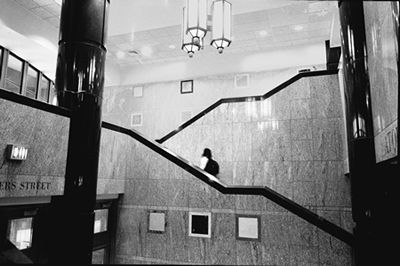 |
| Photographs by Patrick Harbron.
|
The Best and the Brightest
Two decades later Stuyvesant High School received another unexpected gift: a brand new building. When I attended Stuyvesant back in the 1950s, our turn-of-the-century building on East 15th Street was so overcrowded that we went to school in shifts. By the 1980s, the building was falling apart. A committee of Stuyvesant parents and alumni then lobbied state and city officials for a new home. Remarkably, the city agreed to spend $150 million for an ultramodern building on a sliver of land next to the Hudson River in lower Manhattan.
The new Stuyvesant was designed by one of New York’s leading architectural firms. On our initial tour, my wife and I couldn’t believe that we were in a city high school. A pair of marble staircases sweeping up to the second floor greeted us as we entered the building. Two classic black columns soared to the top of the ten-story structure. The school boasts a competition swimming pool, three gymnasiums, a high-tech theater, and ten fully equipped science laboratories. The fifth-floor cafeteria has a balcony with a vista of New York harbor and the Statue of Liberty. Best of all, the building has central air-conditioning, a luxury among city schools.
Each year, the parents association raises more than $300,000 to help pay for a smorgasbord of extracurricular activities. The school offers a 100-piece symphonic orchestra, a symphonic band, a Renaissance choir, and a number of chamber-music ensembles. The debate and math teams regularly finish first in national and regional competitions. Despite its reputation as a refuge for “nerds,” Stuyvesant also fields more athletic teams than any school in the city, including a successful football program.
| The principal of Stuyvesant had no say in filling as many as 50 percent of each year’s teaching vacancies. |
When my wife and I learned that our son Jonathan, and later our younger son, Dani, had been admitted to Stuyvesant, we felt as if we had won the state lottery. They would be surrounded by 3,000 of the city’s brightest students, representing more than 50 different nationalities and ethnic groups. The students seemed to embody the spirit of an achievement-driven city and its succeeding waves of striving immigrants. Though many of them did not count English as their first language, the graduating seniors regularly attained average SAT scores of around 1400. Stuyvesant also frequently produces more National Merit Scholars and semifinalists for the prestigious Intel Science awards than any other school in the nation.
Yet all these accolades tend to mask the school’s dirty little secret. While Stuyvesant admits only the city’s finest students, through a process that is free of subjectivity and nepotism, its hiring decisions are far less merit-driven. Like every other public school in the city, Stuyvesant is plagued by bureaucratic regulations and corrosive work rules that favor seniority and paper credentials over a teacher’s knowledge and skill in the classroom. For instance, according to the teachers’ contract, half of Stuyvesant’s teaching vacancies each year must be posted and set aside for teachers seeking transfers from other city schools. These set-asides are required to be filled solely on the basis of seniority. The fact that many of those selected lack the academic qualifications to teach to the level of Stuyvesant’s students is irrelevant to the union and the school system. The underlying premise of the contract is that any teacher with a state license is fit to teach at Stuyvesant.
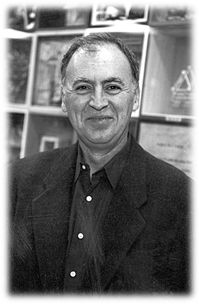 |
| Iftimie Simion was soon teaching college-level math courses at Stuyvesant, yet his job was in danger because he had not accumulated enough credits to qualify for a teaching license. Photograph courtesy of Iftimie Simion. |
The Case of Iftimie Simion
My son Jonathan had an improbable streak of good luck with his freshman-year teachers. The most memorable was Iftimie Simion, a refugee from Romania, who was also in his first year at the school. Simion had taught at the university level for 13 years, coached the Romanian national math team, and published papers in professional journals. By the end of Simion’s first year of teaching, Stuyvesant’s administrators knew they had a rare gem. Simion was soon teaching college-level courses such as multivariate calculus and differential equations to the most advanced math students. He also coached the math team and supervised the math research program. Math department chairman Danny Jaye, a big baseball fan, alternately called him “my MVP” and “my indispensable franchise player.”
In the public school league, however, talent doesn’t count for much. As a recent immigrant, Simion hadn’t yet accumulated enough education credits to qualify for a state teaching license. A citywide teaching shortage had caused the Board of Education to relax the hiring rules, enabling Stuyvesant’s principal to hire unlicensed teachers like Simion. Such teachers, however, were vulnerable to being bumped from the staff if a senior teacher from within the system applied for their positions, which were considered vacant until they attained a permanent credential. One transfer applicant who came close to bumping Simion was a 71-year-old math teacher from Seward Park High School. Though he had logged 35 years in the system, this teacher had never taught at a level higher than first-year Regents math—which 90 percent of Stuyvesant’s freshmen have taken in junior high school. On his first attempt to transfer, members of Stuyvesant’s faculty were able to persuade him that he was not up to the task of teaching the accelerated Stuyvesant curriculum. At the last minute the elderly teacher declined the transfer that was his by right.
But that wasn’t the end of the story. A year later he was again approved for a transfer to Stuyvesant. This time he decided not to let the administrators at Stuyvesant intimidate him. After all, didn’t the union contract stipulate that he was entitled to transfer to any school he preferred? Now 72, and apparently beyond embarrassment, he joined the Stuyvesant math faculty. Fortunately, by then Simion had received his license, and his job was safe.
The students were the vulnerable ones now. The transfer teacher was in his third year of teaching at Stuyvesant when my younger son, Dani, was assigned to him. Dani described him as a decent, gentlemanly man who struggled to get things done in each 43-minute period. Whatever he did came straight from the textbook, and he avoided the more complicated problems or proofs. When I observed his classroom, it was obvious to me that he was completely out of his league. He worked at a snail’s pace with kids who were ready to sprint. He used a crib sheet to steer him methodically through the steps of the solutions to problems he had placed on the board.
With this math teacher the seniority transfer issue at Stuyvesant reached a level of comic absurdity. His lack of mastery was so glaring that he had to sit in on two lower-level math courses at the school. For an entire semester he went to classes, took the tests, and was given grades just like any other student.
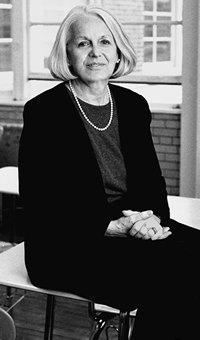 |
| Former Stuyvesant principal J. Cozzi Perullo didn’t like the seniority system and the work rules. And she said so in public. For this she made many enemies.
|
Making Enemies
The issue of transfers became Stuyvesant principal J. (Jinx) Cozzi Perullo’s bête noire—and ultimately led to her resignation. She had begun ruffling feathers from the moment she took the school’s helm in 1994. She didn’t like the seniority system and the work rules, believing they undermined excellence. And she said so in public. For this she made many enemies.
Perullo once described to me a conversation she had with the outgoing principal, Abraham Baumel, in which he told her that she now had the best principalship in the city. At first Perullo was flattered, until she realized what he meant: that Stuyvesant was a great place to be a principal because there was virtually no way to fail. The students guaranteed the school’s academic success. No matter what the principal did, the students would still achieve average SAT scores of 1400 points, and 99.5 percent would go to college.
Perullo conceded that Baumel had a point. “There’s never been a discipline issue here,” she told me. “The kids always do their homework. In some ways Stuyvesant isn’t a ‘real’ school. A teacher could fake it here for 35 years, because even when the teaching is inadequate the kids will find a way to do well on their tests.”
Nevertheless, Perullo was determined to challenge the culture of the union contract. And by challenging the union’s prerogatives she incurred the wrath of Dorothy Suecoff, a veteran biology teacher who served as the school’s United Federation of Teachers (UFT) chapter leader. (Suecoff declined my requests for an interview.) As the enforcer of the union contract, she was in some respects as powerful as the principal. “Her role in the school is to defend the indefensible,” said one of Stuyvesant’s assistant principals.
The biggest weapon in Suecoff’s armory was the elaborate grievance machinery available to the union if a principal should disregard any of the contractual work rules. Once Perullo made clear her intention to try to change some of Stuyvesant’s old ways, Suecoff began filing grievances right and left. She objected to almost every directive coming out of the principal’s office. When Perullo proposed experimenting with block scheduling (double periods for some classes), Suecoff countered with a grievance. When the student newspaper ran an article critical of the union or a particular teacher, a grievance was filed against Perullo on the grounds that the principal was supposed to protect teachers from student criticism.
At the heart of this increasingly bitter confrontation was Perullo’s refusal to drop the issue of the seniority clause. The New York Times quoted her complaining that she had no say in filling as many as 50 percent of the teacher vacancies at Stuyvesant. Without the power to hire and fire teachers, she insisted, principals couldn’t do their jobs.
| At least 16 percent of the total Stuyvesant staff was composed of teachers who received their jobs because of seniority or race and ethnicity rather than professional accomplishments. |
Another part of the contract that troubled Perullo was the “Transfers to Further Integration.” This granted transfer rights for minority teachers into any school that was deemed not to have a fully integrated teaching staff. It was affirmative action plus. Since there was a dearth of blacks and Hispanics in the profession, it meant that a school like Stuyvesant was forced to set aside its openings for any licensed black or Hispanic teacher who put in for the job. Perullo supported the goal of bringing in more minority teachers, but she bridled at the fact that the process was corrupted by the seniority rule. Integration transfers frequently displaced younger, dedicated minority teachers at Stuyvesant who had been groomed by the principal, but had yet to earn tenure rights.
For obvious reasons, seniority and “integration” transfers are especially a problem at schools like Stuyvesant. After all, what veteran teacher wouldn’t want to end his or her career in a luxury building among students who virtually teach themselves? According to Perullo’s count, between 1995 and 2000 Stuyvesant took a total of 24 UFT transfers. In other words, at least 16 percent of the total Stuyvesant staff was composed of teachers who received their jobs because of seniority (or race and ethnicity) rather than professional accomplishments.
In the end, Perullo’s endless battling with Suecoff took its toll. “On a personal level, I had never experienced anything like this in 28 years as a teacher and administrator before I arrived at Stuyvesant,” she told me. “I was not accustomed to my person coming under attack because of my position as principal.” The union leader’s obstructionism did not go unchallenged, but when Suecoff won a re-election for union chapter leader that was essentially a referendum on her tactics, Perullo realized that Suecoff had enough support from the faculty to continue erecting roadblocks. Perullo soon announced her retirement after five years at the school. She minced no words in explaining that the union leadership made it impossible for her to fulfill her goals for the school.
Perullo’s sudden resignation received a surprising amount of media coverage. In interviews she continued to press her contention that principals needed the power to hire and fire teachers to accomplish their mission. This was so abhorrent to Suecoff that she was still waging war against Perullo a year after Perullo’s resignation. Suecoff introduced a resolution at the union executive committee that said Perullo (who still showed up at Stuyvesant from time to time because she was assisting her successor and had other unfinished business) should be barred from the building.
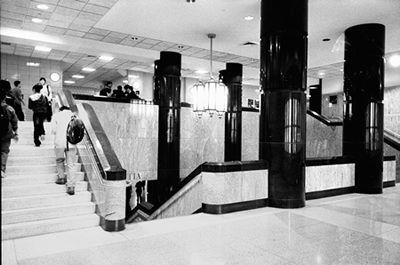 |
| The new Stuyvesant building, designed by one of New York’s leading architectural firms, boasts a competition swimming pool, a high-tech theater, and ten fully equipped science laboratories. The fifth-floor cafeteria has a balcony with a vista of New York harbor and the Statue of Liberty. Photograph by Patrick Harbron.
|
Reunion
As a journalist and frequent critic of the New York City school system, I was invited to participate in a televised forum on the public schools sponsored by the New York City Council. During a discussion on teacher quality, I cited my son’s amazing math teacher, Iftimie Simion, as an example of how “uncertified” doesn’t necessarily mean “unqualified.” This had the serendipitous result of reuniting me with Mr. Simion and teaching me yet another lesson in the sheer stupidity of the New York City school system.
Simion had watched the show and contacted me, seeking advice. He was now in his fourth year at Stuyvesant. He had completed all the ridiculous education courses the system required, including credits in special education and “human relations.” In return the state of New York had finally handed him a piece of paper that said he was qualified to teach high-school math, as he had already been doing brilliantly. But a Board of Education bureaucrat somewhere deep in the bowels of 110 Livingston Street had decided that it was too complicated to evaluate Mr. Simion’s doctoral-level training in Romania (partly because some documents had been lost in his flight from his homeland). Thus Mr. Simion was denied the salary increment given to teachers who have attained a master’s degree plus 30 credits.
He was also penalized by one of the most senseless clauses in the teachers’ contract. It stipulated that a teacher coming into the system from any other school district (either public or private) could not be given salary credit for more than five years of previous teaching experience. The cap on experience had been put into the contract at a time when there was a surplus of teachers rather than a shortage. Even the UFT was now against the clause and proposed eliminating it (the policy has since been amended to credit teachers for up to eight years of experience).
All told, Simion was earning about $20,000 less than he should have been. His salary was also $35,000 less than that of the incompetent 74-year-old math teacher who had come close to replacing him. Meanwhile, two nearby suburban districts were offering Simion a higher salary scale and said they would recognize his previous years of experience in Romania. (Stuyvesant physics teacher Van Caplan had left for the suburbs a year earlier partly because the city refused to recognize his 20 years of teaching at West Point.) Although Mr. Simion loved teaching at Stuyvesant, he also had a family to support, and his son was about to enter college.
It occurred to me that if common sense didn’t work at the Board of Education, plain embarrassment might. I called David Klassfeld, then Chancellor Harold Levy’s top deputy and, coincidentally, a Stuyvesant parent. I knew that Klassfeld was aware of Simion’s reputation, and Klassfeld knew what it would say about the Board of Education if Simion left the Stuyvesant math department because of the idiotic rules. Klassfeld also knew that I would write about the situation in whatever media outlet afforded me the space.
Shortly thereafter, Klassfeld called back to tell me that a partial solution had been found for Simion. A committee of outside experts had been convened at the Board to evaluate the coursework of teachers who had attended foreign universities. In fact the committee had already looked into Simion’s case and ruled that he was entitled to the salary increment for education. He would even be paid the increment retroactively, dating back to his first year of teaching at Stuyvesant. The back payment of about $16,000 plus the extra $4,000 added to his base salary persuaded Mr. Simion to stay on at Stuyvesant for at least one more year. Two years later, however, he left for the suburbs, partly because he was fed up with a system that considered every math teacher with a license the same as every other teacher, no matter how much talent they brought to the classroom, and that never fully compensated him for his many years of high-level teaching experience.
Nevertheless, it was amazing to see how quickly the rules can change when there is the will to do so. I felt that I had made a small contribution to Stuyvesant’s legacy of math and science excellence. I decided that I should do even more to undermine the oppressive rule of seniority and mediocrity at the school.
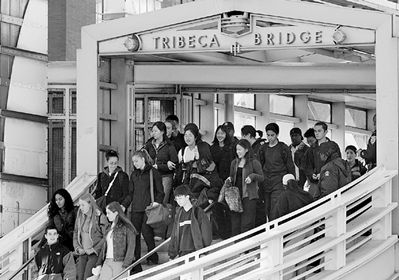 |
| Stuyvesant frequently produces more National Merit Scholars and semifinalists for the prestigious Intel Science awards than any other school in the nation. Photograph from AP/World Wide.
|
Obstruction
Stuyvesant had just recently put into place its School Leadership Team (SLT), a reform mandated by the state. This was supposed to be a vehicle for parents, teachers, and students to collaborate in school improvement. In theory, if the SLT reached a consensus, it could make major decisions about school practices that the principal was then required to carry out. The parents association elected the parental representatives, and I chose to participate as an observer with the intent of pressuring the elected representatives to raise the issue of seniority.
Still, I had few illusions about the SLT’s potential as a reform tool. There was a big catch-22 in the enabling legislation: an SLT could not adopt any policy that conflicted with the union contract. The first SLT meeting I attended had the look of a United Nations Security Council meeting. The meeting opened with many delegates expressing frustration that almost nothing had been accomplished in their year of existence. This was attributed, much as it might have been at the U.N., to excessive procedural wrangling or to the power of one permanent member.
Dorothy Suecoff had apparently played the role of the many Soviet ambassadors to the U.N. during the cold war, who just kept saying nyet and vetoed just about every resolution passed by the Council majority. The SLT would work through several meetings on an issue and arrive at a consensus, only to be told by Suecoff that the proposed change violated the teachers’ union contract.
In one such instance the SLT had adopted a resolution calling for the principal to start an experiment with block scheduling. The idea was to have some teachers voluntarily teach some classes for two periods in a row for an hour and a half instead of one 43-minute period every day. (This was essentially the same proposal Jinx Perullo had made three years earlier.) A tremendous amount of time and effort went into drawing up the plan, including a visit by some delegates to Thomas Jefferson High School in Virginia, which uses block scheduling. But the proposal was killed at the end of this elaborate process when Suecoff filed a grievance with the superintendent of Manhattan High Schools. She claimed that the block scheduling would have meant that some teachers actually spent more than the contractual limit of teaching five periods in one day—even though this would be balanced by teaching fewer than the five periods on other days. Suecoff’s grievance was upheld, even though the teachers in question would have volunteered to teach the block schedule.
| “Every time the students try to bring up a program to improve education, we are told it violates the teachers’ contract,” said student Matt Kelley. “It seems like education improvement is itself a violation of the contract.” |
To try to head off a similar fiasco in the future, one of the SLT subcommittees proposed a resolution requesting delegates to inform the SLT early on if they believed that a proposed initiative would “contravene a union contract or state education law.” The resolution was clearly aimed at the UFT chapter chair, the only person who was invoking the union contract to kill proposals. Suecoff was actually on the subcommittee that had proposed the resolution, and everyone believed she had agreed to it.
Suecoff sat expressionless as the resolution was read. She then made the following announcement: “I can’t be bound by this resolution. I represent the staff. I have the right to file a grievance against this committee.” Many of the delegates were shocked by this response. As one parental delegate put it, no one disputed the right of the UFT chair to file grievances. All that was asked of Suecoff was to let the delegates know when she thought they were headed into territory covered by the union contract. Suecoff wouldn’t even offer her fellow delegates that crumb. She insisted that she wasn’t going to provide the SLT with the benefit of her interpretation of the contract. “A grievance is a private matter,” she added with emphasis.
This provided an enlightening introduction to the politics of school reform for the five student representatives on the SLT. The leader of the student delegation was Matt Kelley, a tall, handsome senior with longish blond hair who frequently mocked the principal’s pretensions about Stuyvesant’s being a great science and math school. “A lot of us came to Stuyvesant because of the math and science,” Kelley once pronounced, “but then we discovered that the worst teaching was in those subjects.”
Kelley often needlessly antagonized teachers and administrators. Nevertheless, I credit him with going directly to the heart of the matter on the subject of the union contract. At one meeting the student delegates pushed for teachers to set aside time during the day to meet with students—in the same way that college professors are required to have office hours. This was an eminently reasonable request, since Stuyvesant teachers were notorious for leaving the building as soon as their last teaching period was over. Many even arranged their schedules so that they worked a five-hour day or less.
Suecoff responded that the proposal was a non-starter because all the hours of the school day allowed by the contract were already accounted for. A visibly frustrated Kelley then blurted out, in the truest words I had ever heard in the SLT meetings: “Every time the students try to bring up a program to improve education, we are told it violates the teachers’ contract. It seems like education improvement is itself a violation of the contract.”
-Sol Stern is a contributing editor at City Journal. This essay is adapted from Breaking Free: Public School Lessons and the Imperative of School Choice (Encounter Books, 2003).


